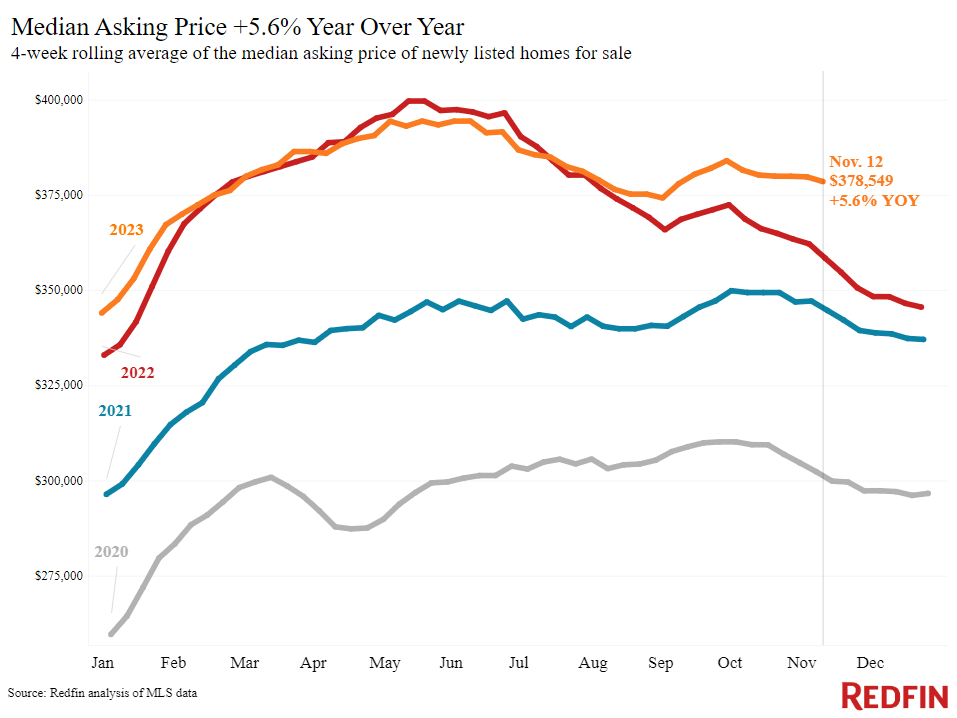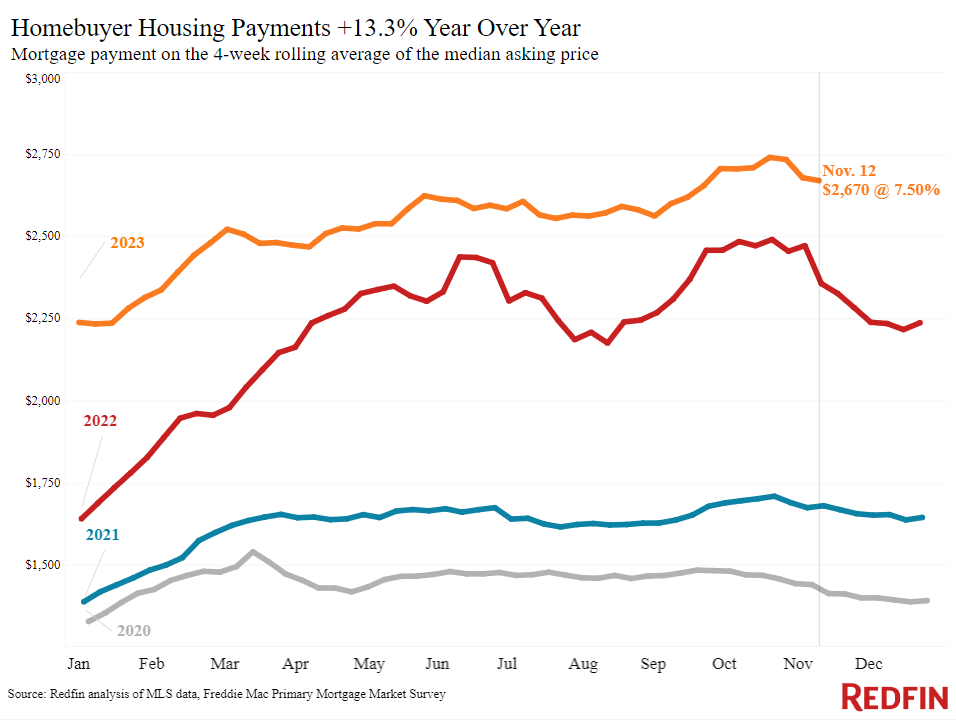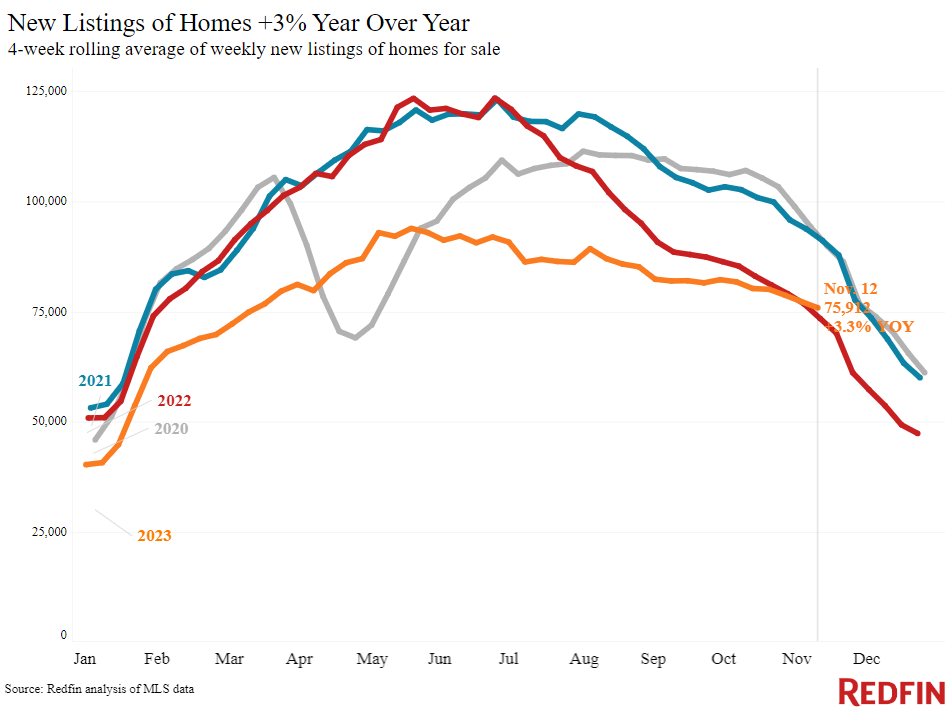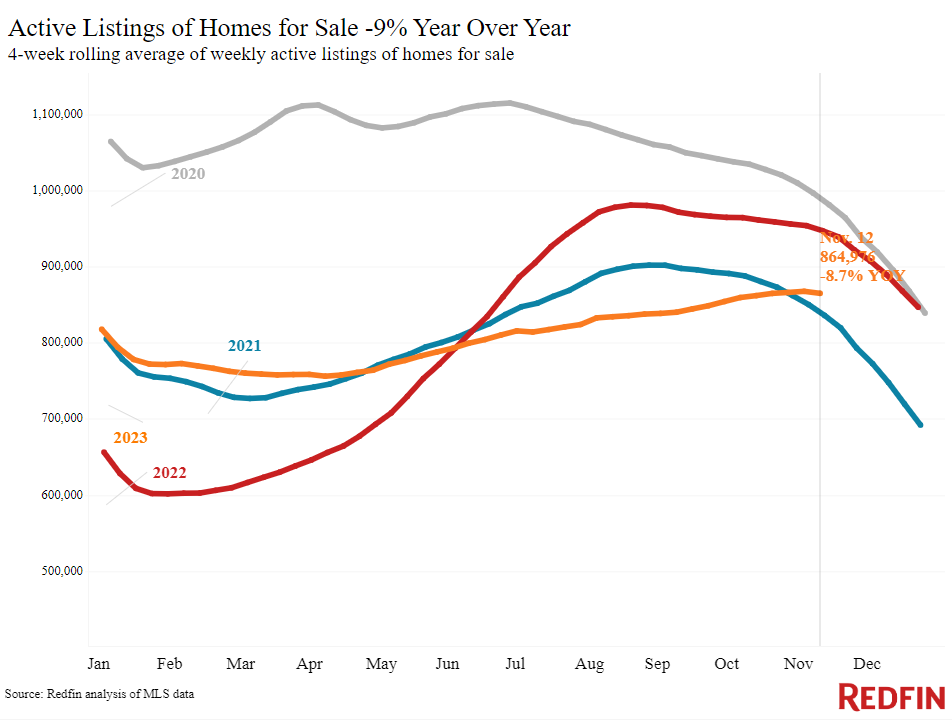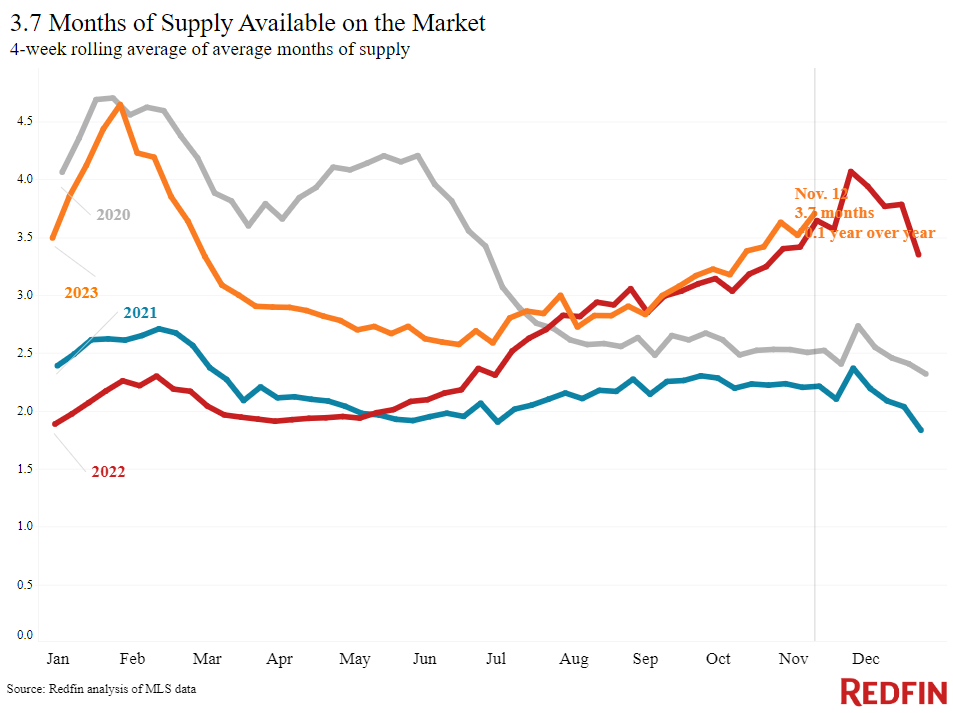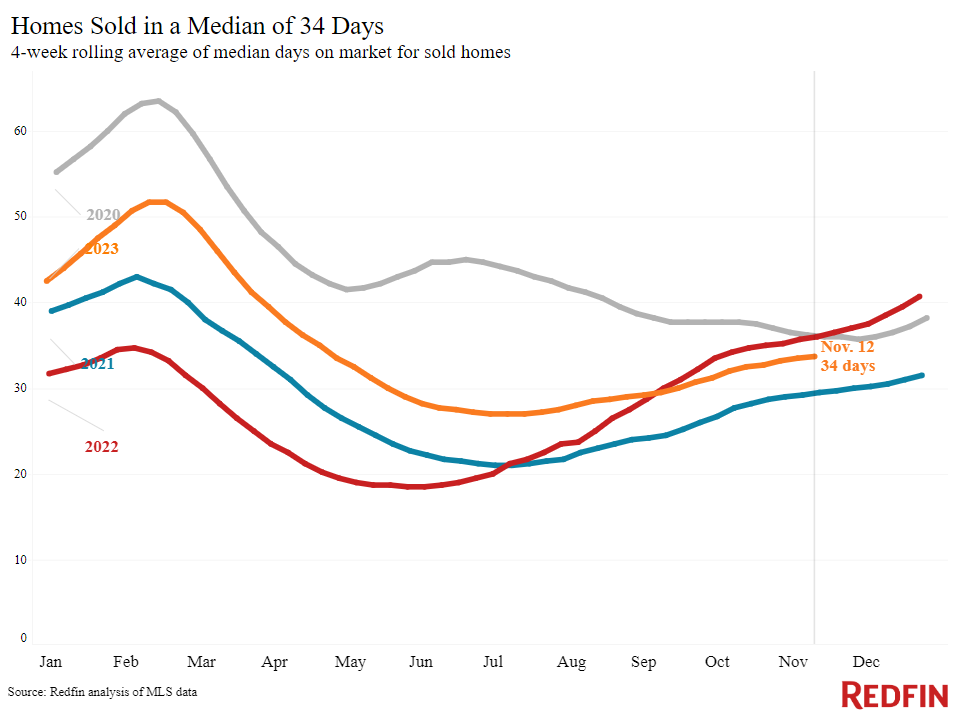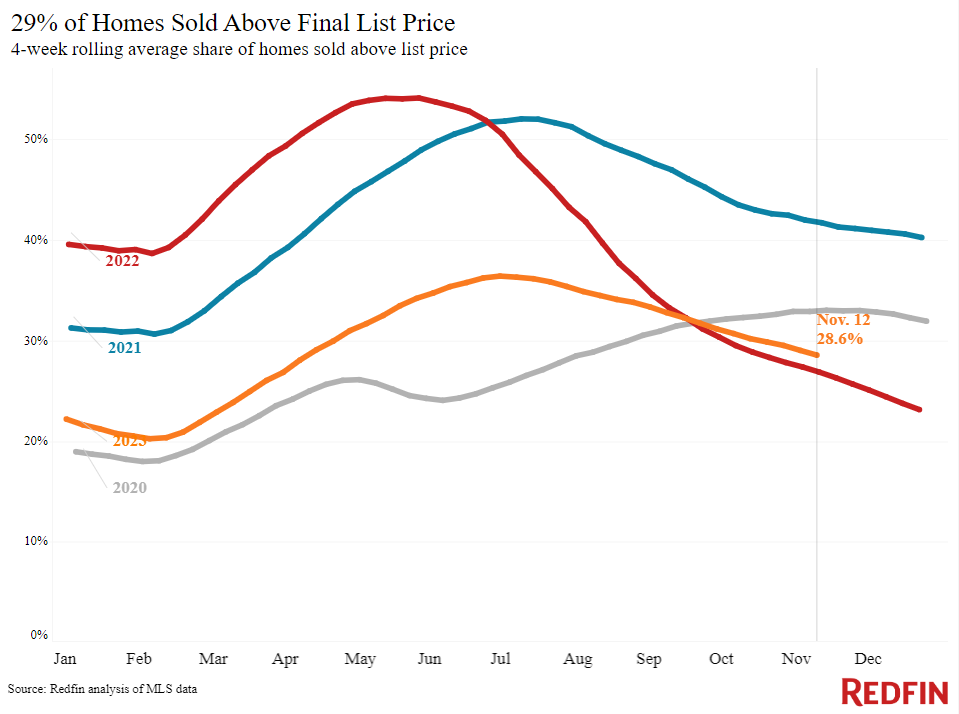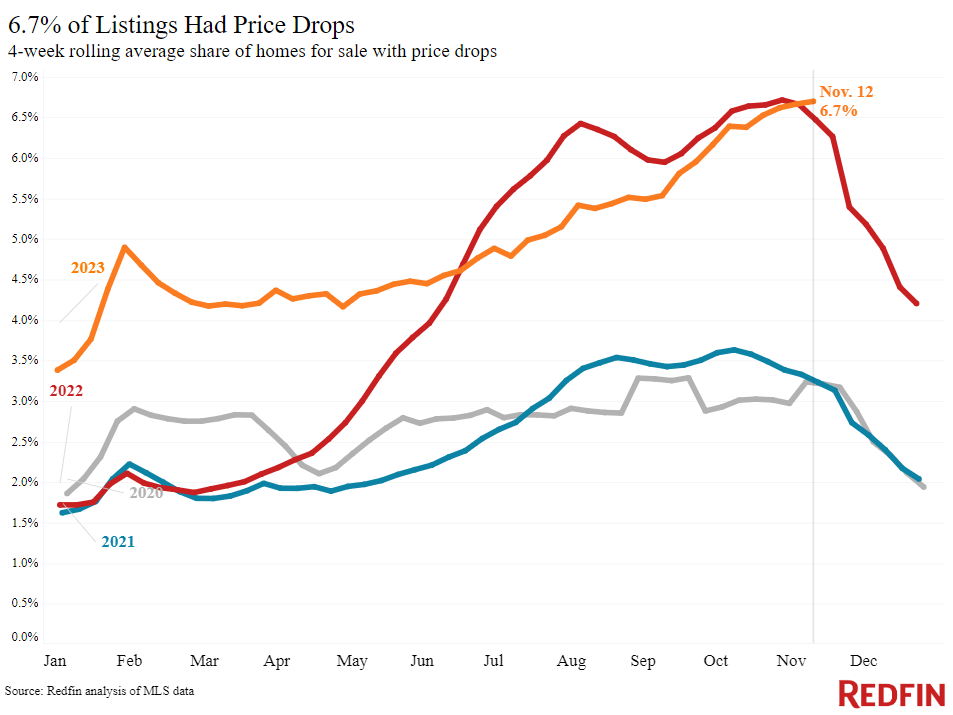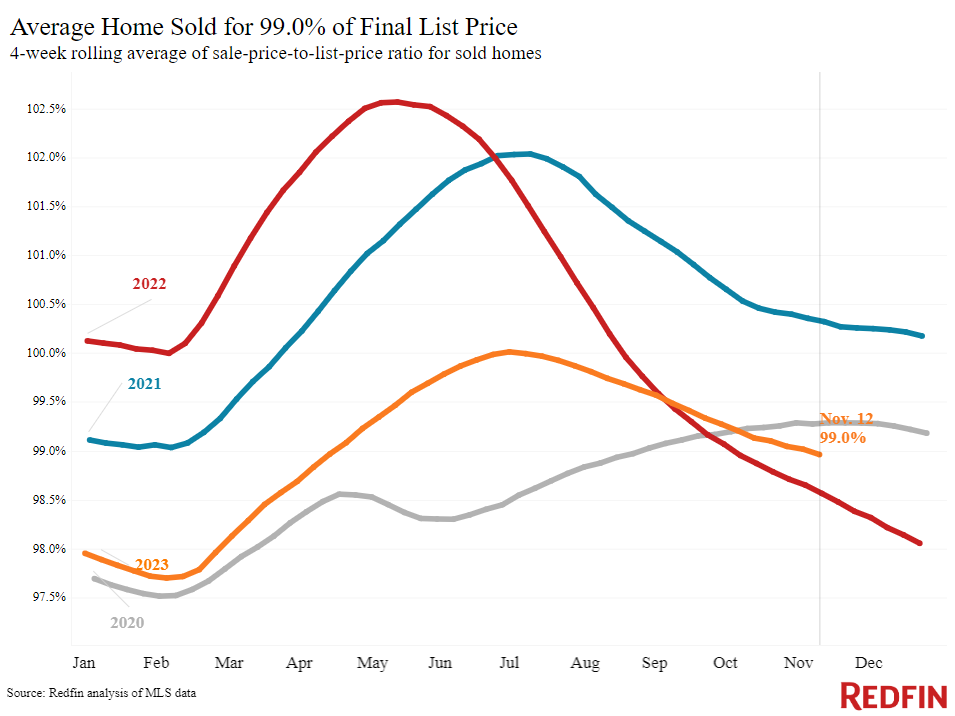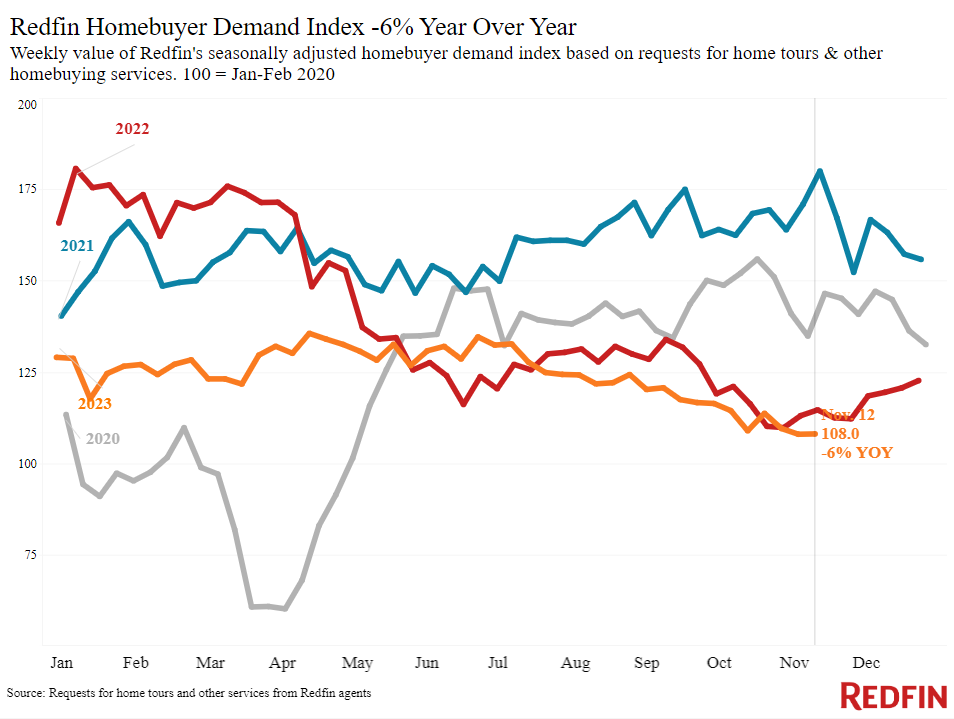It’s a chicken-or-egg situation for homebuyers and sellers. Demand is rising partly due to an uptick in new listings, and listings are increasing partly because sellers are noticing more buyers enter the market.
Mortgage-purchase applications are on the rise. Mortgage-purchase applications rose 3% from a week earlier during the week ending November 10, bringing them to their highest level in five weeks. That marks the second straight week of increases. And while pending home sales were down 8% year over year during the four weeks ending November 12%, that’s one of the smallest declines since April 2022. House hunters are coming off the sidelines because mortgage rates are dropping from their peak: Average rates have declined from a two-decade high of 8% to the 7.4% range in the last month.
Promising inflation report = good news for rates. Mortgage rates are declining partly because this week’s CPI report shows that inflation is easing. That means it’s almost certain the Fed won’t hike interest rates again this year–and they may start cutting rates earlier than expected.
More sellers are jumping in, too. New listings of homes for sale are up 3% from a year earlier, the biggest increase in two years and just the second increase since July 2022 (the first was last week). The total number of homes for sale is near its highest level since the start of the year. There’s a variety of reasons why more homeowners are putting their homes on the market: Some are noticing the small uptick in homebuyer demand, some are worried home prices are going to decline if they wait any longer, and others are ready to give up their low mortgage rate after realizing rates are unlikely to drop back to pandemic-era levels anytime soon.
Leading indicators
| Indicators of homebuying demand and activity | ||||
| Value (if applicable) | Recent change | Year-over-year change | Source | |
| Daily average 30-year fixed mortgage rate | 7.45% (Nov. 15) | Down slightly from 7.48% a week earlier, close to lowest level since mid-September | Up from 6.65% | Mortgage News Daily |
| Weekly average 30-year fixed mortgage rate | 7.5% (week ending Nov. 9) | Down from two-decade high of 7.79% two weeks earlier | Up from 7.08% | Freddie Mac |
| Mortgage-purchase applications (seasonally adjusted) | Up 3% from a week earlier (as of week ending Nov. 10) | Down 12% | Mortgage Bankers Association | |
| Redfin Homebuyer Demand Index (seasonally adjusted) | Essentially unchanged from a month earlier (as of the week ending Nov. 12) | Down 6% | Redfin Homebuyer Demand Index, a measure of requests for tours and other homebuying services from Redfin agents | |
| Google searches for “home for sale” | Unchanged from a month earlier (as of Nov. 11) | Down 10% | Google Trends | |
| Touring activity | Down 30% from the start of the year (as of Nov. 6) | At this time last year, it was also down 30% from the start of 2022 | ShowingTime, a home touring technology company | |
Key housing-market data
| U.S. highlights: Four weeks ending November 12, 2023 Redfin’s national metrics include data from 400+ U.S. metro areas, and is based on homes listed and/or sold during the period. Weekly housing-market data goes back through 2015. Subject to revision. | |||
| Four weeks ending November 12, 2023 | Year-over-year change | Notes | |
| Median sale price | $367,998 | 4.2% | Biggest increase in a year. Prices are up partly because elevated mortgage rates were hampering prices during this time last year |
| Median asking price | $378,549 | 5.6% | Biggest increase in over a year |
| Median monthly mortgage payment | $2,670 at a 7.5% mortgage rate | 13% | Down $70 from the all-time high set 3 weeks earlier |
| Pending sales | 66,773 | -8% | |
| New listings | 75,912 | 3.3% | Second year-over-year increase since July 2022. The increase is partly because new listings were falling at this time last year. |
| Active listings | 864,976 | -8.7% | Smallest decline since July. Close to their highest level since the start of 2023. |
| Months of supply | 3.7 months | +0.1 pt. | 4 to 5 months of supply is considered balanced, with a lower number indicating seller’s market conditions. |
| Share of homes off market in two weeks | 35.8% | Up from 32% | |
| Median days on market | 34 | -2 days | |
| Share of homes sold above list price | 28.6% | Up from 27% | |
| Share of homes with a price drop | 6.7% | +0.2 pts. | Record high (tied with previous week) |
| Average sale-to-list price ratio | 99% | +0.4 pts. | Lowest level since April |
| Metro-level highlights: Four weeks ending November 12, 2023 Redfin’s metro-level data includes the 50 most populous U.S. metros. Select metros may be excluded from time to time to ensure data accuracy. | |||
| Metros with biggest year-over-year increases | Metros with biggest year-over-year decreases | Notes | |
| Median sale price | Anaheim, CA (12.9%) Cincinnati, OH (12%) San Diego, CA (11.9%) Providence, RI (10.9%) Newark, NJ (10.4%) | Austin, TX (-8.1%) San Antonio, TX (-3.1%) Detroit, MI (-1.2%) Fort Worth, TX (-1%) Tampa, FL (-0.5%) Nashville, TN (-0.5%) | Declined in 6 metros |
| Pending sales | San Jose, CA (12%) Las Vegas (0.9%) Detroit (0.7%) Anaheim, CA (unchanged) San Francisco (unchanged) | Portland, OR (-22.6%) Providence, RI (-17%) Virginia Beach, VA (-16.8%) New Brunswick, NJ (-16.2%) New York (-15.7%) | Increased in 3 metros, stayed the same in 2, and declined in the others |
| New listings | San Jose, CA (24%) West Palm Beach, FL (19.7%) Phoenix (15.8%) Tampa, FL (12.3%) Montgomery County, PA (11.2%) | Atlanta (-17.8%) Portland, OR (-15.9%) Seattle (-9.7%) Indianapolis, IN (-9.2%) Newark, NJ (-9.1%) | Declined in roughly half the metros |
Refer to our metrics definition page for explanations of all the metrics used in this report.
